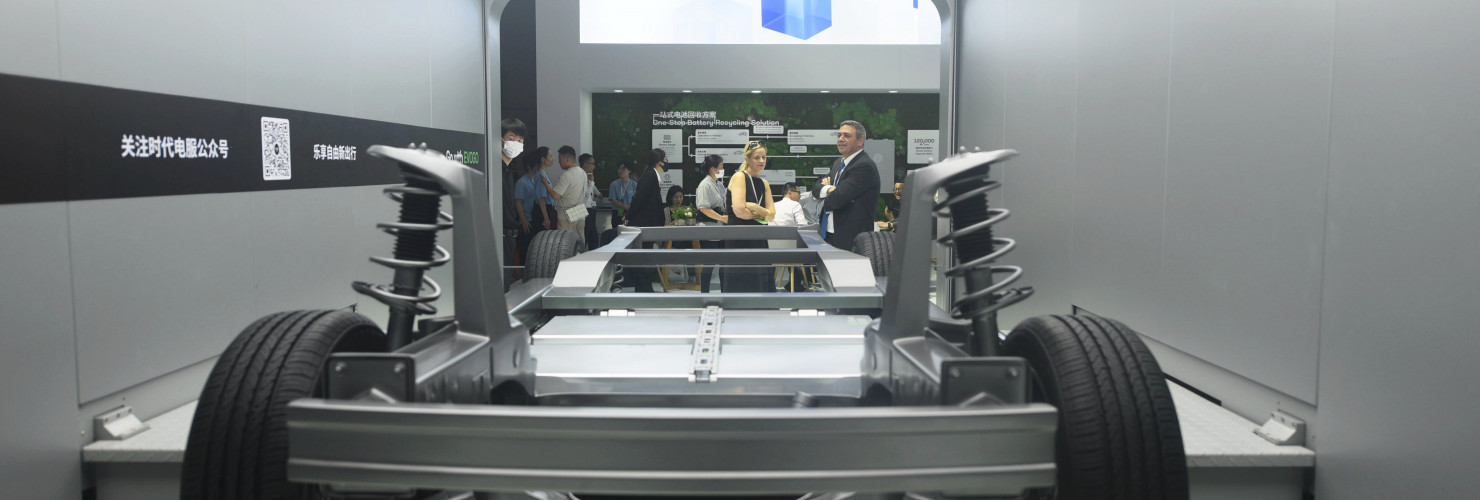

Watts the plan, Europe – Chinese battery investments on or off?
Industry leaders CATL and BYD are eying investments in Europe rather than in North America. Gregor Sebastian says Brussels and member states cannot do nothing – but also cannot pull the plug.
Europe has become the primary target for the international expansion of Chinese electric vehicle (EV) battery producers. What looks like a signal of confidence from China is also a sign of weakness, as the region lacks strong battery makers of its own. European countries as a result face a tricky dilemma – they need battery investment to reach their decarbonization goals, but also fear becoming dependent on China and distorting the European single market by ushering in state-sponsored companies.
Chinese battery manufacturers dominate their home market thanks to inhouse innovation, government support and a robust manufacturing base. This focus on the world’s leading EV market has already made China’s CATL and BYD larger and more profitable than their more globalized main rivals from South Korea and Japan, such as LG Energy and Panasonic (see graph). This is allowing Chinese producers to drive down costs and increase spending on research and development (R&D).
![]() Hover over/tap the chart to see more details.
Hover over/tap the chart to see more details.
Exhibit 1
Some Asian battery makers favor Europe, others North America
After concentrating on their home market in their early years, Chinese battery makers are increasingly branching out. In 2022 and 2023, they announced overseas investments in factories with an annual capacity of 411 Gigawatt hours (GWh), enough to power about four million long-range electric vehicles. This total was more than the 398 GWh of foreign capacity planned by their South Korean rivals – and conspicuously focused on Europe and the 13 million vehicles it makes every year.
Global battery investments are in consequence seeing a significant geographic split. South Korean and Japanese companies are concentrating on North America, in particular leveraging incentives from the subsides available from the USA’s Inflation Reduction Act (IRA). One of Washington’s aims is to free US supply chains from Chinese battery makers, creating uncertainty for their investment plans in North America. After considering sites in the US and Mexico, CATL halted plans for a North American plant.
![]() Hover over/tap the map to see more details.
Hover over/tap the map to see more details.
Exhibit 2
Chinese battery production in Europe could bring vital benefits…
Europe, the world’s second-fastest growing EV market, is in contrast maintaining an open stance towards Chinese investment. This offers a tremendous opportunity for battery makers from China – and for Europe. With ambitious decarbonization targets, Europe urgently needs batteries for EVs to maintain its competitiveness in car manufacturing. Without strong manufacturers of its own, only Chinese producers can offer the cost-effective lithium iron phosphate (LFP) batteries that do the trick.
Chinese battery investments could also address the imbalance in investment between Europe and China. While European companies invest heavily in China, the latter's investment footprint in Europe remains relatively small. Chinese battery plants would also attract raw material processing and battery material investments, benefitting Europe's battery supply chain. In the event of a crisis, all this local production would threaten China with considerable sunk costs – and boost Europe's resilience.
… and two potentially long-lasting drawbacks for the region
This – and the fact Chinese firms accounted for only a quarter of total announced battery capacity in Europe in April 2023 – makes the risks associated with Chinese battery investments seem manageable. But any increased dependence could pose challenges as the European Commission and the EU’s member states emphasize reducing risks in dealing with China. Xi Jinping's aim to increase Beijing’s global influence by leveraging clean energy, in particular batteries, should give pause for thought.
Furthermore, Chinese battery investments could distort the European single market. Although Brussels’ has lifted state-aid restrictions in the battery sector and European governments are now willing to provide tax-payer money in support, Beijing's assistance to its battery makers is in a league of its own. For instance, in 2019, government handouts accounted for 18 percent of Chinese battery maker CALB's revenues. The state-affiliated company is currently planning to build a 15 GWh plant in Portugal.
Chinese battery makers also benefit from state-backed credit and equity financing that is cheaper than any offered on the financial markets, enabling them to scale up production capacity over and above their commercial means. They also benefit from cheap battery materials – cathode producer Guizhou Anda has production joint ventures with two Chinese municipal governments, allowing it to rein in production costs. These distortions have made China’s EV market and now risk spilling into Europe.
Striking a balance with resolute use of Europe’s legal powers
The pros and the cons mean Europe has to find a balance. A full embrace would bring the production of innovative and cost-effective batteries to the region and promote local EV production and decarbonization – at the cost of increasing China's leverage and weakening domestic battery producers. A tougher stance against Chinese battery makers would promote homegrown battery capabilities and avoid new dependencies on China – but at what cost to the EV plans of European car manufacturers?
One thing Europe can’t do is to kick the can down the road. Instead of betting on European battery innovations with which it could leapfrog China, Europe should work on the premise that Chinese companies will more likely commercialize new technologies first. While their dominance isn't guaranteed, it should bear in mind that CATL and BYD spent USD 2.1 billion and USD 2.6 billion on R&D in 2022, three and four times more than South Korea’s LG Energy, their closest foreign competitor.
Of course, Brussels and member states should continue encouraging investments from South Korean and Japanese companies and homegrown expertise critical in green technology. But Europe should also welcome Chinese battery investments as a contribution to the region’s economy and environment. But it should also be ready to resolutely enforce free and fair competition – expressly including its new powers to sanction foreign companies unfairly benefitting from subsidies from other governments.
